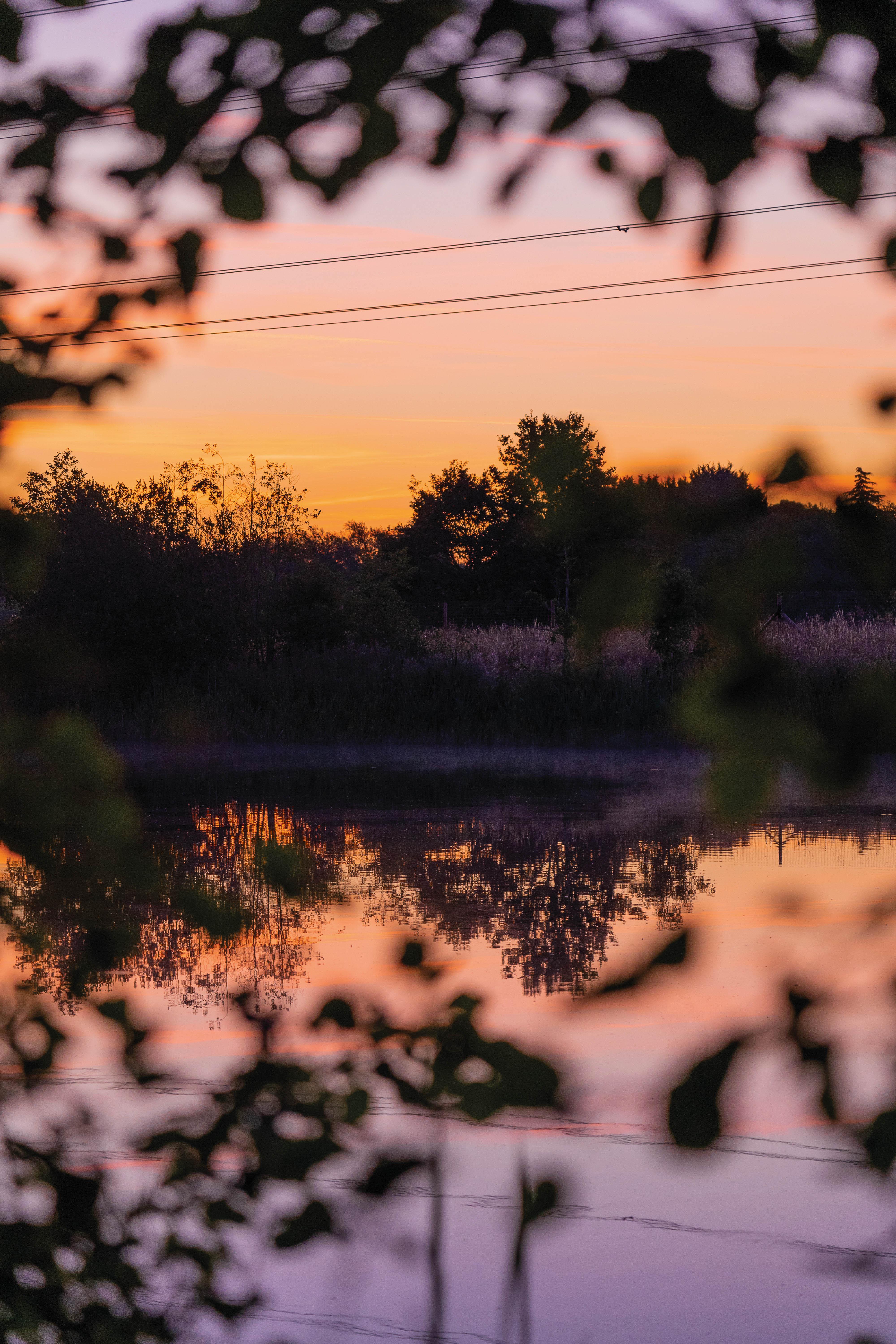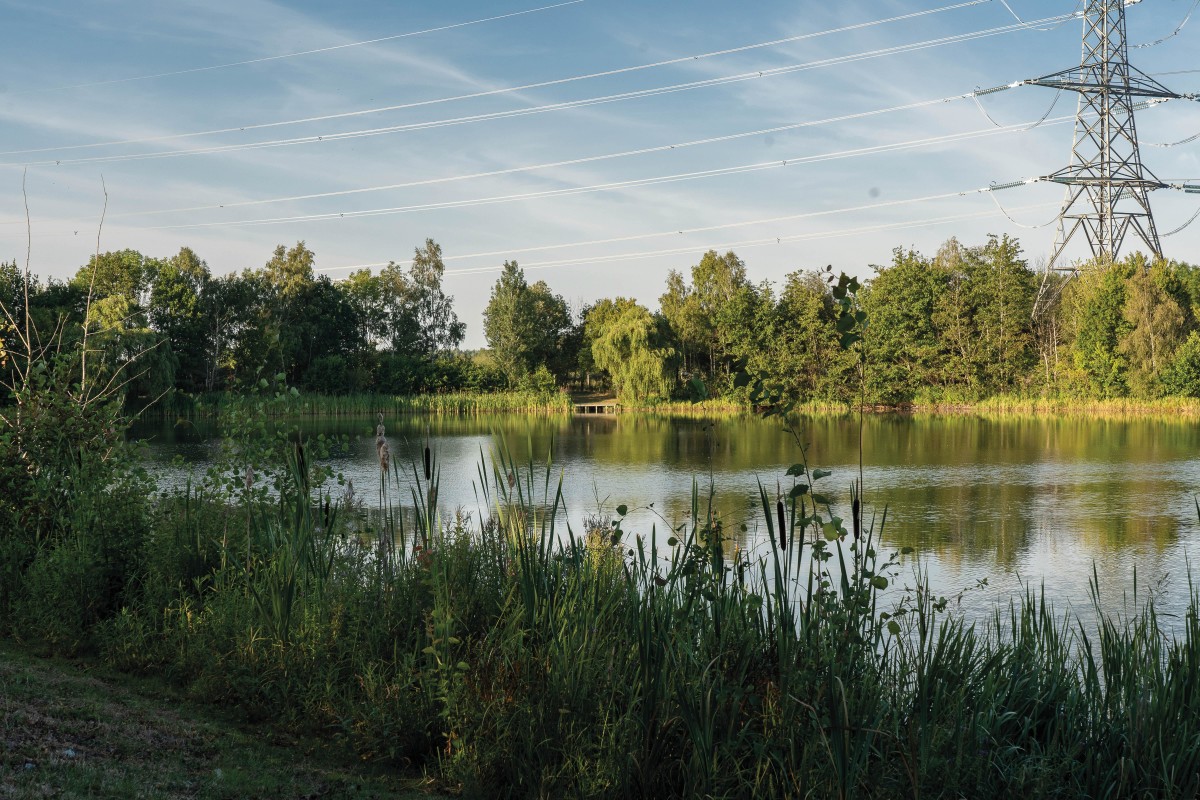
Open Access Venue: The Cove, Girton
Stu Lennox and Chris Eaglestone head for a venue in Nottinghamshire where an ample and varied stock, and excellent on-site facilities make for just what our open-access experts had in mind...
The Cove is one of a number of lakes set within the Girton complex. Nestled in the Nottinghamshire countryside, the fishery was originally dug in the late 1990s when sand and gravel were extracted. The 10-acre Cove lies alongside its more famous big brother, Girton A, where its biggest resident, at over 64lb and affectionately known as Butthead, resides. The Cove actually used to be a part of Girton A, the two lakes joined by a narrow channel.
Carp Classic Ltd purchased the site around 2013, and the channel was filled in a couple of years later, to make two separate lakes. The lakes are stocked and managed by Ant, a partner in Carp Classic Ltd, and the team at AJS Fisheries. In the first three years, somewhere between 200 and 300 fish were stocked each winter, to complement any originals that remained.
These fish were a mix of the classic, hallmark AJS scalys, some Croatian crosses known for their growth rates, and a handful of Fisher Pond carp. The area is renowned for its unavoidable flooding from the River Trent. A few years back, the whole complex flooded and stocks became jumbled. Some of the fish from Girton A ended up in the Cove, and a lot of the Cove’s stockies made their way next door. These fish now thrive in the larger lake, and having reached mid- to upper-twenties, they will continue to grow.
A final stocking last winter puts the estimated total stock in the Cove at around 600 fish. It now holds six known thirties, seventy-five twenties, and the rest are fast-growing doubles. The exciting part is the unconfirmed number and size of both the originals that remained after the two lakes were separated and the escapees that came in during the flooding.
The lake offers access to an on-site club house which incorporates a toilet, shower block, kitchenette, fridge, freezer and barbecue, and a lovely wooden social seating area. In short, it has everything you need for the perfect social weekender.
Finally, to make everything as easy as possible, when you arrange your trip, you can also pre-order boilie and particle, along with the pellet the fish are regularly fed on. Because of Covid and on-site works, the lake had been fished only rarely over the three years before we visited, and so the fish remain really receptive to a bit of bait. Now the books are open again, visiting anglers are sure to enjoy some incredible angling.
The Cove has 10 pegs, all sited along one bank, and this sees every swim command its own water. More importantly, perhaps, neighbouring anglers can spend time with one another of an evening. The lake is incredibly deep, an average of 25ft across most of the open water, and down into 35ft in parts. The margins shelve down nicely, with plenty of areas being flat enough to present a bait in, say, six, nine or twelve feet of water. There is scattered weed all over, but there are plenty of clear areas to fish to. The main hotspots are the margins, either on the far bank or on your own side.
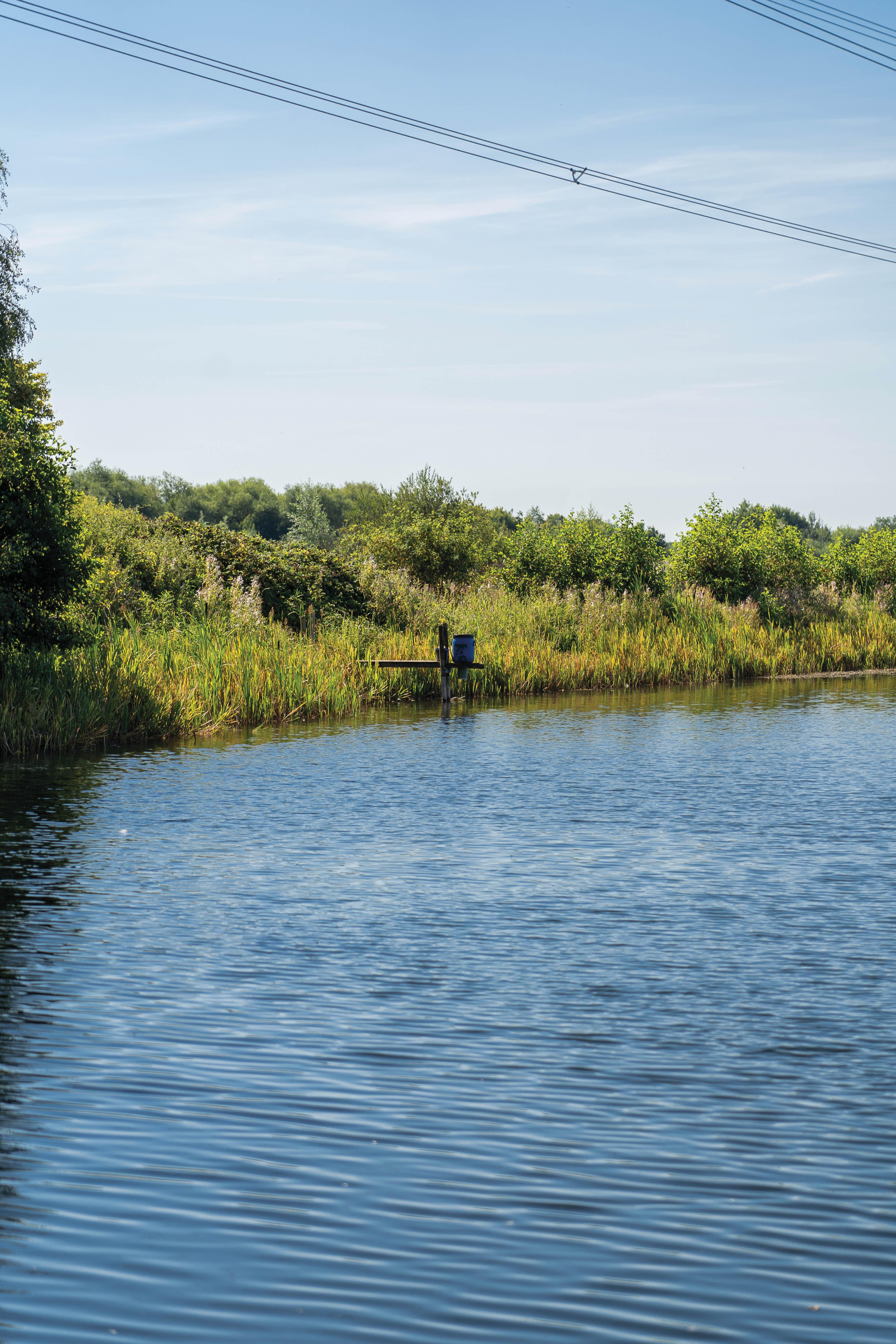
Stu Lennox: I hadn’t seen Chris for a couple of months, so we decided to go somewhere for a proper tear-up! The Cove was the perfect choice, and is well suited to anyone looking for an exclusive booking for a social, birthday, family trip or similar, and somewhere you are all going to catch stacks of fish—we didn’t realise quite how many fish were in there until we arrived. The pegs are well spaced, but close enough for neighbouring anglers to share a barbecue and a few drinks of an evening, so we were really looking forward to finally spending a bit of time together as we also enjoyed the fishing.
Having arrived, we were let in and were soon walking around the lake. We skipped Peg 1 as that’s the only peg sited on its own and not suitable for a social. We didn’t have to go far, though, and in Peg 2 we immediately saw some fish enjoying themselves in the early morning sun. Some were quite close in, and there was another group out to the left in the little bay. I cut the walk short and went straight back to the car for my floater gear. I wanted to put a few floaters out and see if we could get them going as we walked the rest of the lake. I put a few pouchfuls out of mixed size before continuing with the walk.
Pegs 3, 4, 5 and 6 have the most water on the lake, with the biggest chucks to the far margin. It was about 120yds to the far side, but over there were a few blue, barrel pellet feeders. The fish have been fed from these almost their entire lives, and undoubtedly, they are the hotspots on the water. When you walk round and look into the water around these feeders, the bottom is completely polished, with none of the pondweed present that can be found elsewhere in the margins, and there are always fish to be seen. Shortly after pellet has been fed, these areas can resemble an aquarium, given the number of fish that turn up. As 120yds is not a cast all anglers will make, these areas aren’t always fished, so the carp often feed there without being disturbed. We had earmarked these areas before we turned up, and this was where we would most likely start, if we saw nothing else as we wandered round.
Further up, into Peg 7 and beyond, the lake narrows. Here, the far margin can be reached with a chuck of 80 to 90yds, depending on which peg you’re fishing from. This area looked okay but unremarkable, until we walked into Peg 10. The final fishable peg on the lake offers access to a large sheltered bay. As soon as we walked into the peg, we saw numbers of fish. The more we looked, the more we appreciated the ridiculous number of fish that were out in front of us. There must have been 40 or more carp spread over an area measuring around 50 metres by 50 metres. Most were just bobbing about enjoying the sunshine, whilst some drifted up and down the very shallow margins to the right. We could just about see back to Peg 2, and there, a couple of fish were taking floaters. There were nowhere near the number of carp we had in front of us in Peg 10, however, so we decided to make a start at the end and see how we got on.
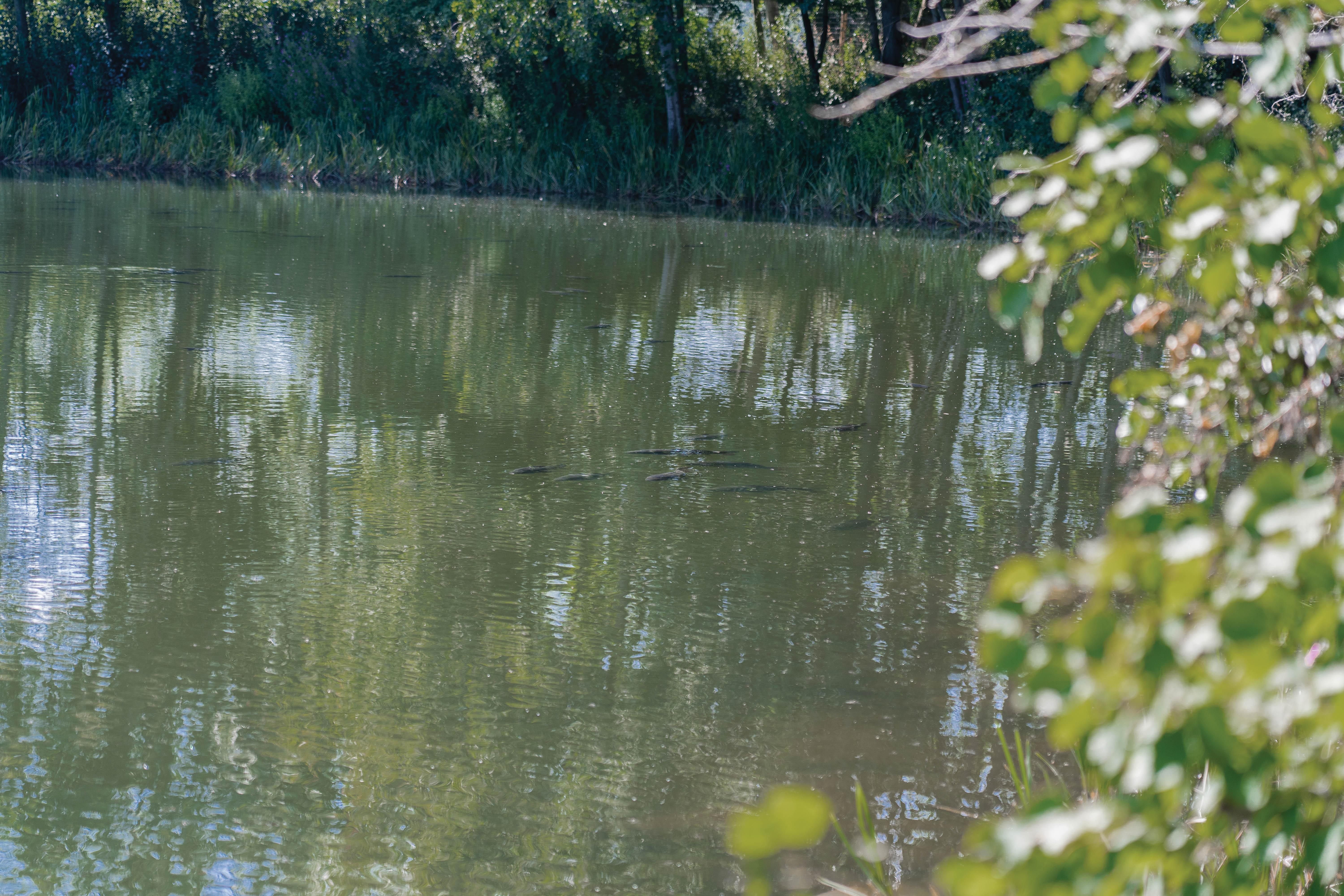
Chris Eaglestone: Stu had carried his floater gear round with him, so I grabbed his bucket and fired out a few pouchfuls of floaters. He was using a mix of 6mm and 11mm Sticky The Krill and the same in standard floating trout pellet. This created a nice, varied mix of size, buoyancy and flavours, and prevented them becoming too preoccupied with any one type of offering. There was little drift, so I had to place the floaters closer to the fish than I would have liked. The first pouchful went out and a group of about 10 fish that had been drifting up and down the margin spooked and immediately left. This was annoying, but there were still plenty of fish to be angled for.
Another pouchful went out… and another group left the peg! This wasn’t ideal, but we cracked on. I set up an inline Nash Bolt Machine controller, with a hooklength of about four feet and a trimmed-down pop-up, attaching it to a Flota Claw hook via a Hair Rig. Wherever you looked in the swim, a few fish were taking floaters, so I made a cast beyond the largest group. As it landed, the controller spooked a group of fish I hadn’t seen. I persevered, slowly retrieving the hookbait back to place it among the group of taking fish. They continued to take free offerings around my hookbait, but never really looked like taking the hookbait itself, and I believe I had a few refusals.
Having made a cast, Stu set up his gear with a view to fishing around me. He opted to fish a bubble-type float, bolt-style, with a slightly longer hooklength and his usual trimmed-down 12mm Sticky Manilla pop-up. He went really long, to the back of the swim where a couple of fish had been clearing up everything that had drifted in.
Soon after, what was an excellent piece of angling saw him looking at his phone as his line tightened in his hand before he was into the first fish of the session, without even realising it. The fish was small, but seemingly turbocharged. It tore up and down the swim, spooking other fish everywhere it went, before it eventually hit the net. It was a small but pretty mirror of about 10lb, a fish with a big frame and plenty of room for growth. I helped him land it and immediately got my rod back out while he sorted the photos. After another couple of refusals, I then had a take that I managed to connect with. It was then my turn to do battle with a turbocharged double that also careered all over the swim.
My fish seemed particularly intent on burying itself in the right-hand marginal reeds. Luckily, the water there isn’t deep enough for the fish to get snarled up in the reeds, but the fish still tried to bury its head in every single clump on the way in. Whilst a little bit bigger than Stu’s fish, it was another low double.
A fish each in an hour of angling had been a great start to the trip, but after all the disturbance, the bay was almost completely devoid of carp. It was time, therefore, to decide what we were going to do for the rest of the day, and hopefully get something going for the evening.
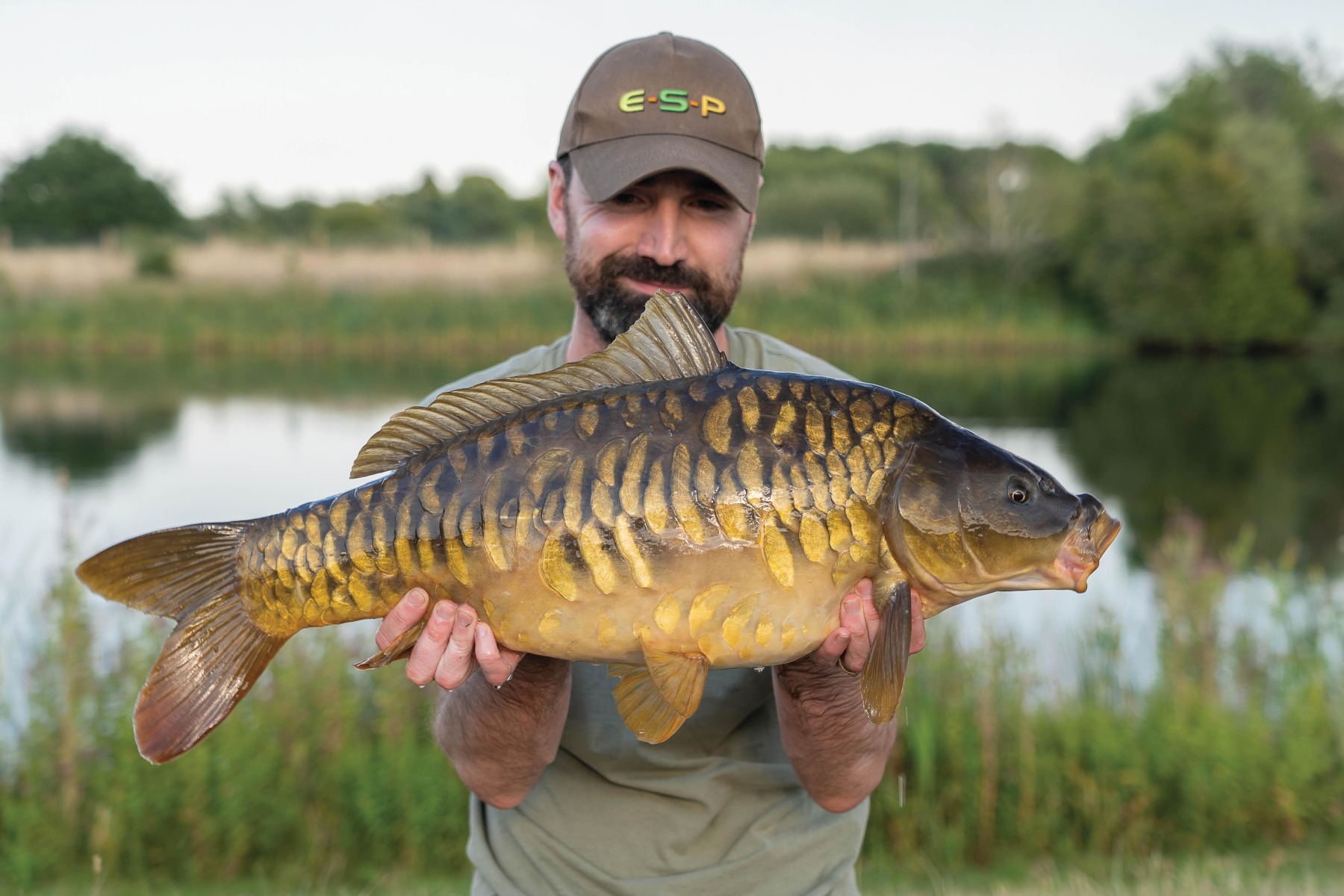
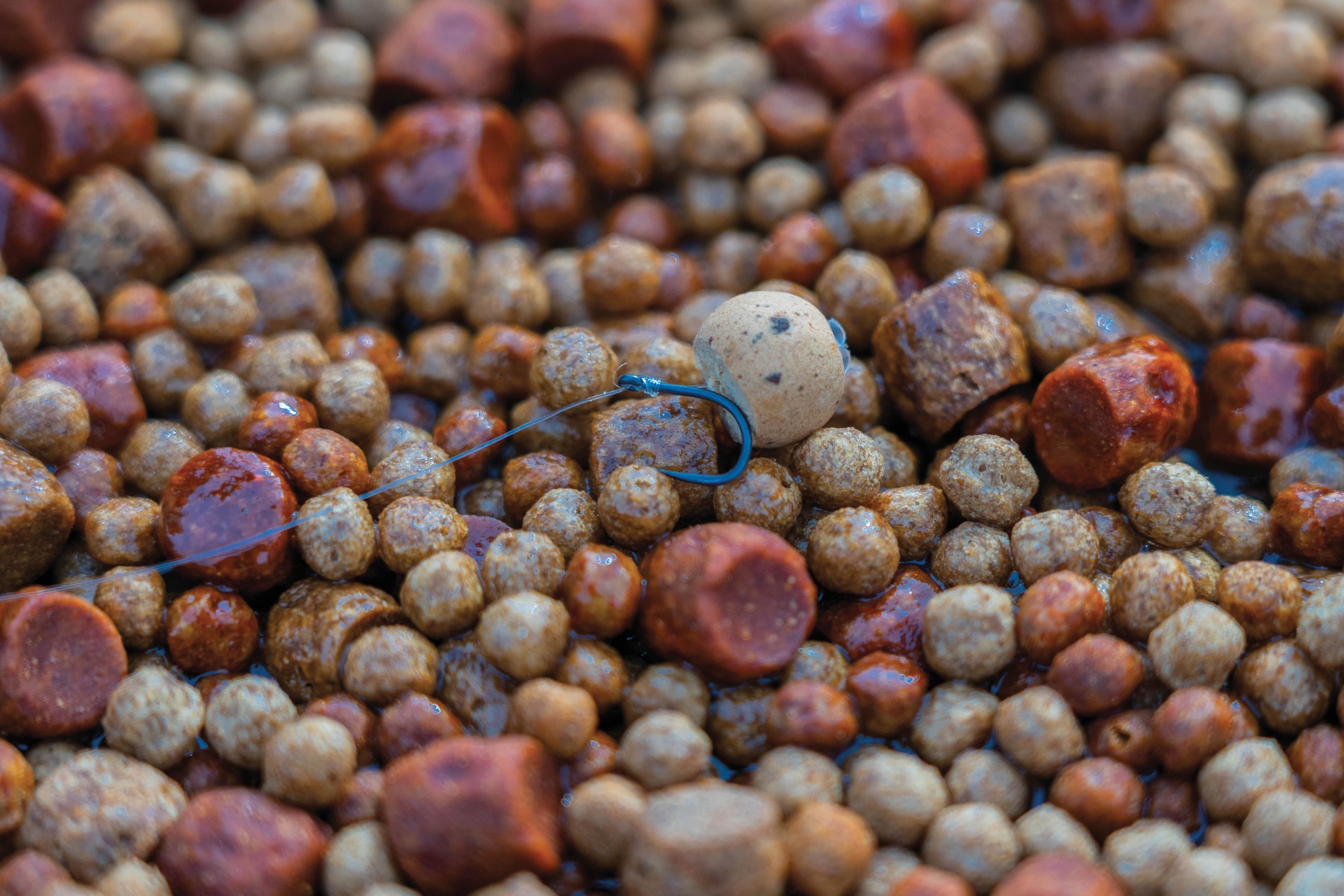
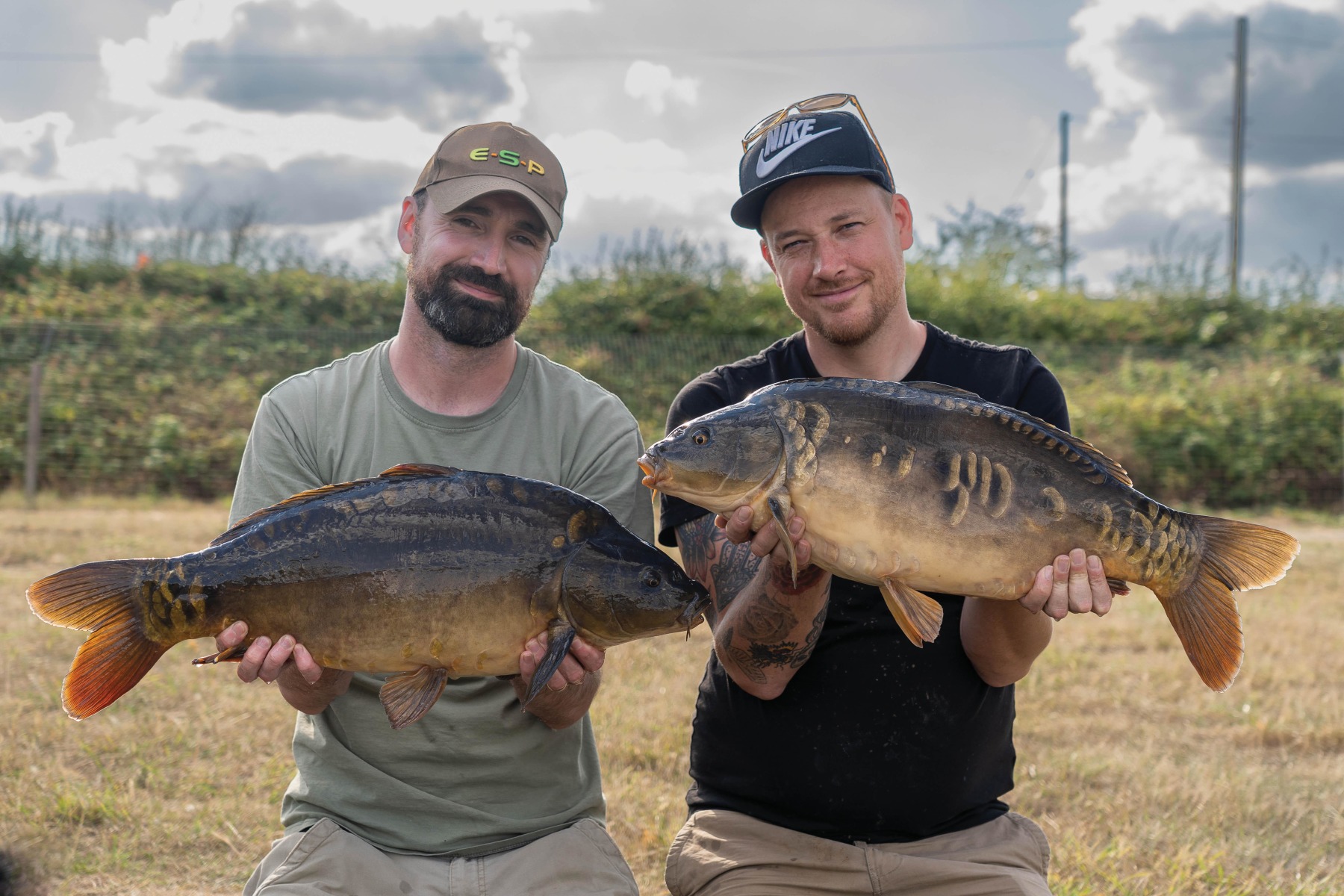
SL: We conducted the usual toss of a coin to see who got first pick of pegs for the evening, and lo and behold, Chris won again. That made it ten in a row—or at least it certainly felt like it. He elected to stay in Peg 10. Whilst the fish had vacated for the time being, he felt that there were so many in there when we’d arrived, they would undoubtedly return.
Whilst Peg 1 had a large number of fish in front of it, we had come for a social, so I dropped in next to Chris, in Peg 9. There was an overhanging tree and a large bed of lilies on the far bank, so I was relatively happy with the options I had. I decided to kick off with solid bags and had tied a number up in advance using the excellent Gemini Tidy Stems. These make re-casting after a fish or a miscast so much easier, and on waters like the Cove, where I was expecting constant action, they can really help you in your efforts to build a hit of fish.
My bag mix included a combination of Sticky Baits’ 2.3mm bloodworm and Manilla pellets, Krill Powder, crushed 6mm bloodworm pellet, Himalayan rock salt and hemp oil. This created a very attractive pile of small food items. The oil would travel up through the water column to draw fish down, and the different powders would linger on the lakebed, even after all the contents of the bag had been eaten.
My hookbaits were small pop-ups glugged in Korda’s Pink Almond Goo until they became wafters, or 10mm homemade blackcurrant wafters. These were fished on short, braided hooklengths, on which I was trying out the brand-new ESP Cryogen Claw-Hammers. These feature a beaked point and have a wide gape, but the point length has been increased and they are ‘sticky’ sharp—throughout the time I spent tying my rigs, I continually pricked myself. I also had some identical rigs tied with the original Cryogen Grippers for comparison.
I chose three spots on the far margin: one up against the overhanging tree, one in the gap between the tree and the lilies, and one on the left-hand side of the lilies. The two left-hand rods were in six to nine feet of water, with the rod against the tree slightly deeper, in twelve to fifteen feet—I’d placed this one further out because of the overhanging branches. I’d managed to get just two of the three rods out before the first, in the gap between the tree and pads was away. Once again, the fight was spirited, the fish stripping line on its initial run, despite it clearly being another relatively small one. Having pumped it in from range, it was soon in the net.
This fish looked like it was from a completely different stock to the first. It appeared much fresher, with a heavily scaled linear line and an immaculate mouth. There had clearly been a number of different stockings, this fish being from the most recent, last winter, and I was looking forward to seeing what we would catch next.
Living locally, my wife and children had come down to visit, and to drop off some bits I had forgotten. We’d never all been on the bank together before, and it was lovely to show them a few the Cove’s residents. Whilst they (Jack!) didn’t necessarily behave for the photos, we now share some incredible memories.
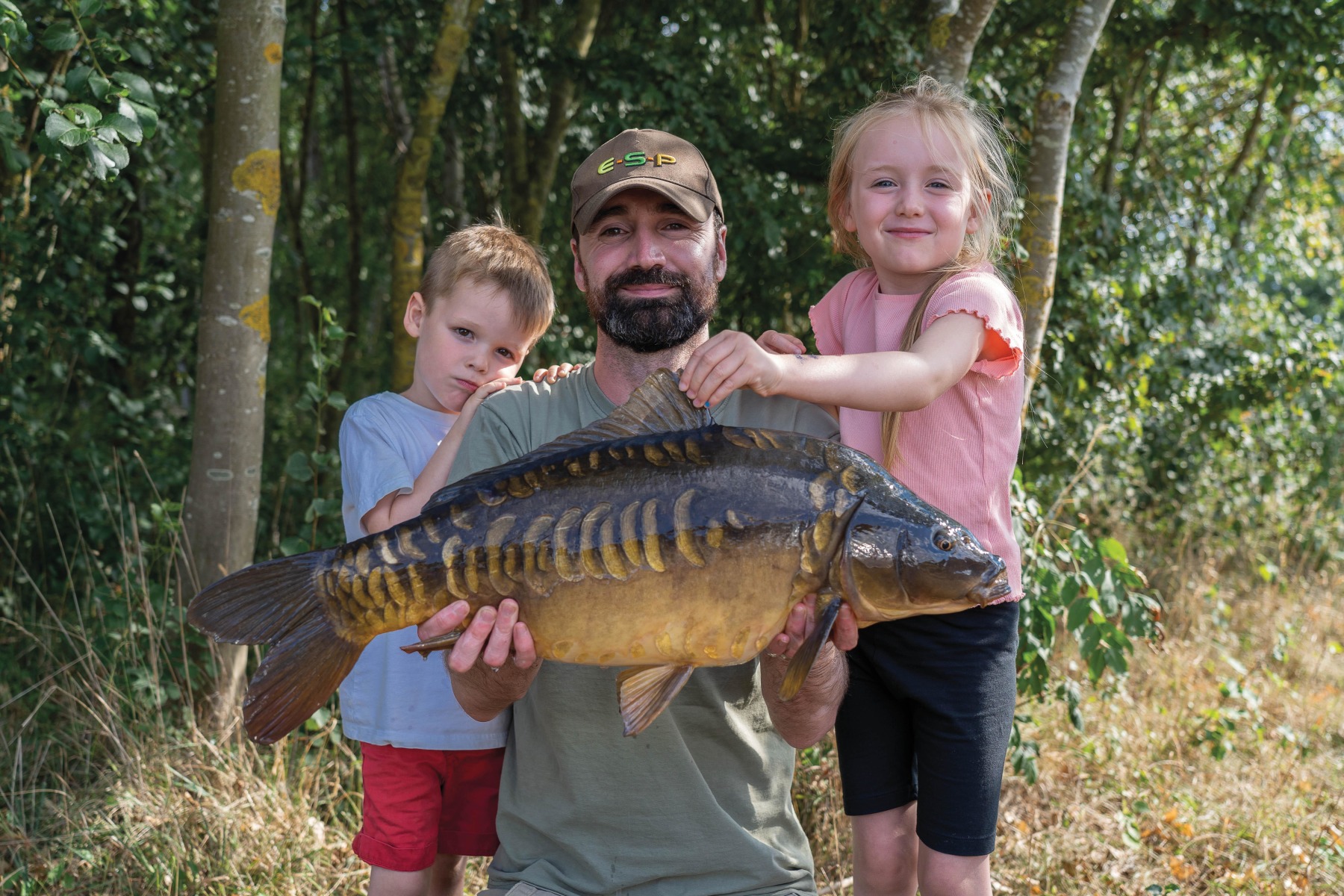
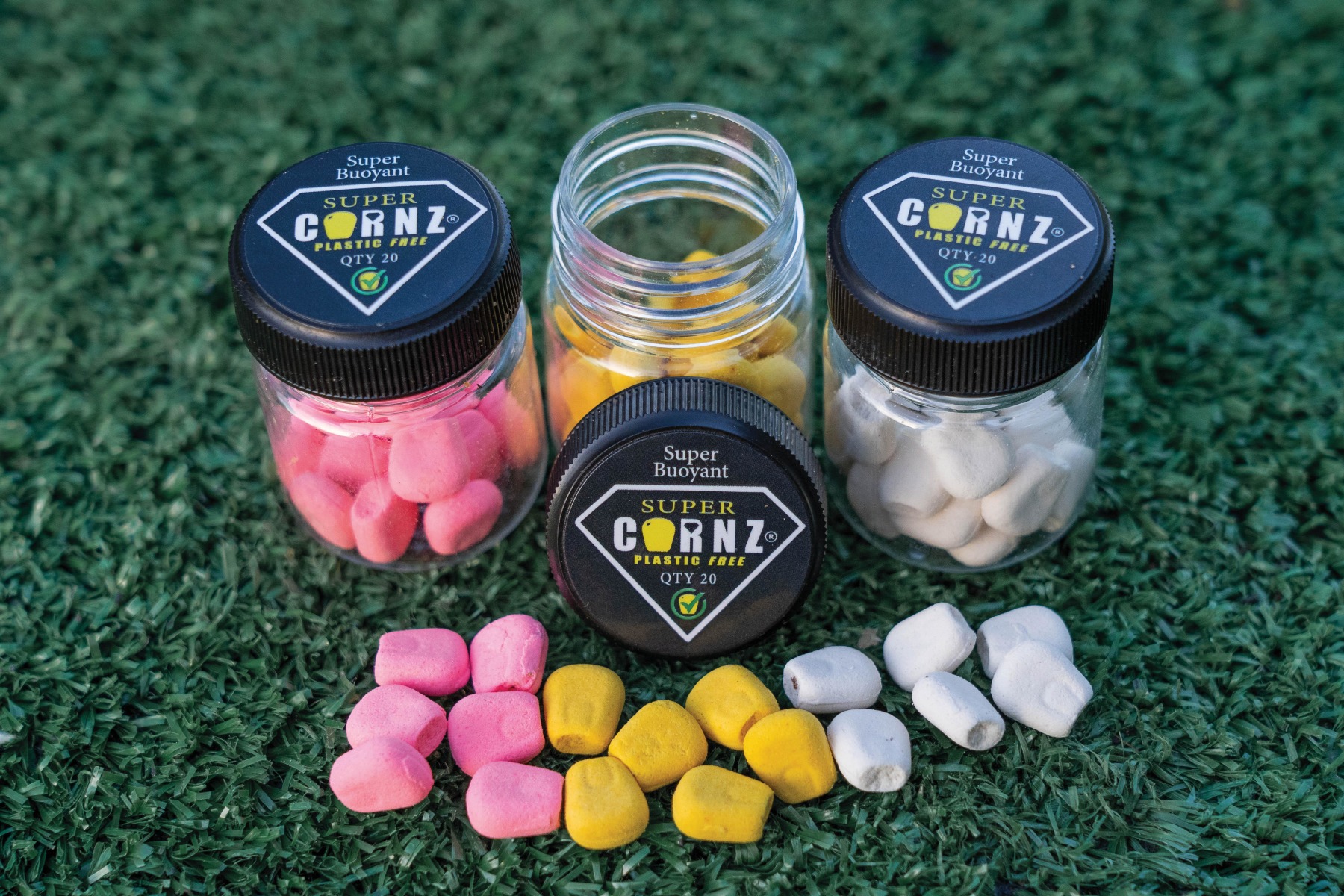
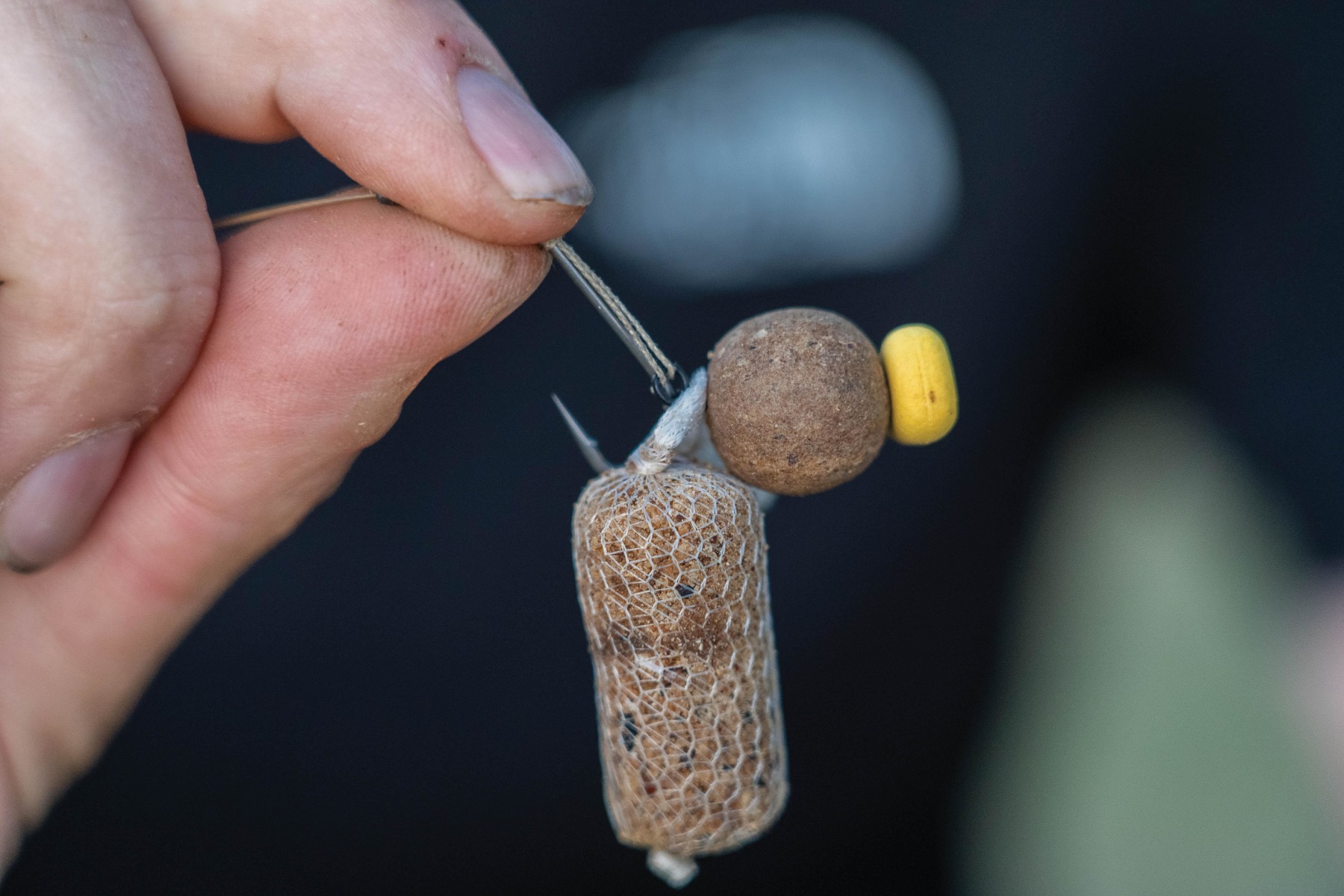
CE: Back in my peg, I fed more floaters, this time 11mm Nash Slickers, while I retrieved my gear from the van. During the time it took to set up my bed and bivvy, they never really got going, but I did feel that I might have a chance back in Peg 2. I got my floater gear together and went for a wander. After a few pouchfuls of pellet, the fish slowly started to take again. I trimmed down another pop-up and made a cast. Frustratingly, the fish never settled. They were taking the odd pellet here and there, but every cast or pouchful of pellets saw them move around the swim in front of me. Wherever I fished, they fed elsewhere.
I could see that Stu had made a quick start and that he had landed his first fish, followed by a second, quite quickly. He then reeled in his rods and wandered down to see how I was getting on. Never one to miss an opportunity off the top, he had brought his floater gear, and after politely checking whether it was okay to do so, he made a cast in my swim, away from where I was fishing. Annoyingly, he was almost instantly into a fish. This had happened twice during this session, and had happened once or twice previously when we’ve been on our travels.
This led me to believe that there was something not quite right with my floater presentation. I would get a bite eventually, but Stu’s set-up seemed to bring much quicker takes. When his fish—another low double—hit the spreader block, I decided to change my set-up to something very similar to what he was using. I scaled down to a smaller, thinner-wire size 10 to the Flota Claw, and swapped over to a 12mm Manilla pop-up. Stu has had his pop-ups for a long time. Significantly air-dried, they are very buoyant and biscuit-like, and they hold a floater hook up for some considerable time.
On the first cast on the new set-up, I was into a fish straight away, which proved that the changes had made a difference. My fish made for a nice brace shot alongside Stu’s. The back-to-back fish had, once again, resulted in the majority of the other carp spooking, so I headed back to peg 10 to get sorted for the night.
Straight out in front was a very inviting snaggy bush, and an old, collapsed platform that looked like it used to hold a pellet feeder. I assumed there would be a polished spot nearby, just as with the other feeders, and on my first cast to the area, the lead cracked down, slightly to the right of it, rather than directly in front. The area had been previously cleaned off, but maybe wasn’t as polished as the spots further down the lake. I decided to stick two rods on it, and one to the snaggy bush.
When at Linear’s Tar Farm for the first article of this series, I had real success using Hinged Stiff Rigs over boilie. Whilst Stu had caught a number of fish, I’d had a run of a much better stamp, all going over 20lb. My plan was to do exactly the same on this occasion. Stu’s fish had been doubles, so I decided to sit things out with the Hinged Stiff Rigs, in the hope of banking a few larger ones. I use a size 5 Nash Chod Twister and 25lb Chod-Link, the booms being made with 25lb Korda Boom. One thing I do like to do is crimp the loop at the lead end much longer than is usual, at around three-inches. This creates a very stiff loop and increases the anti-tangle properties of the set-up as it kicks the rig away from the lead on every cast. The rigs were fished on normal lead clips with some tubing. Hookbaits were Tails Up Sea Monsta pop-ups fished over the matching 16mm bottom baits. Having spread about three kilos over the area, I settled down for the evening.
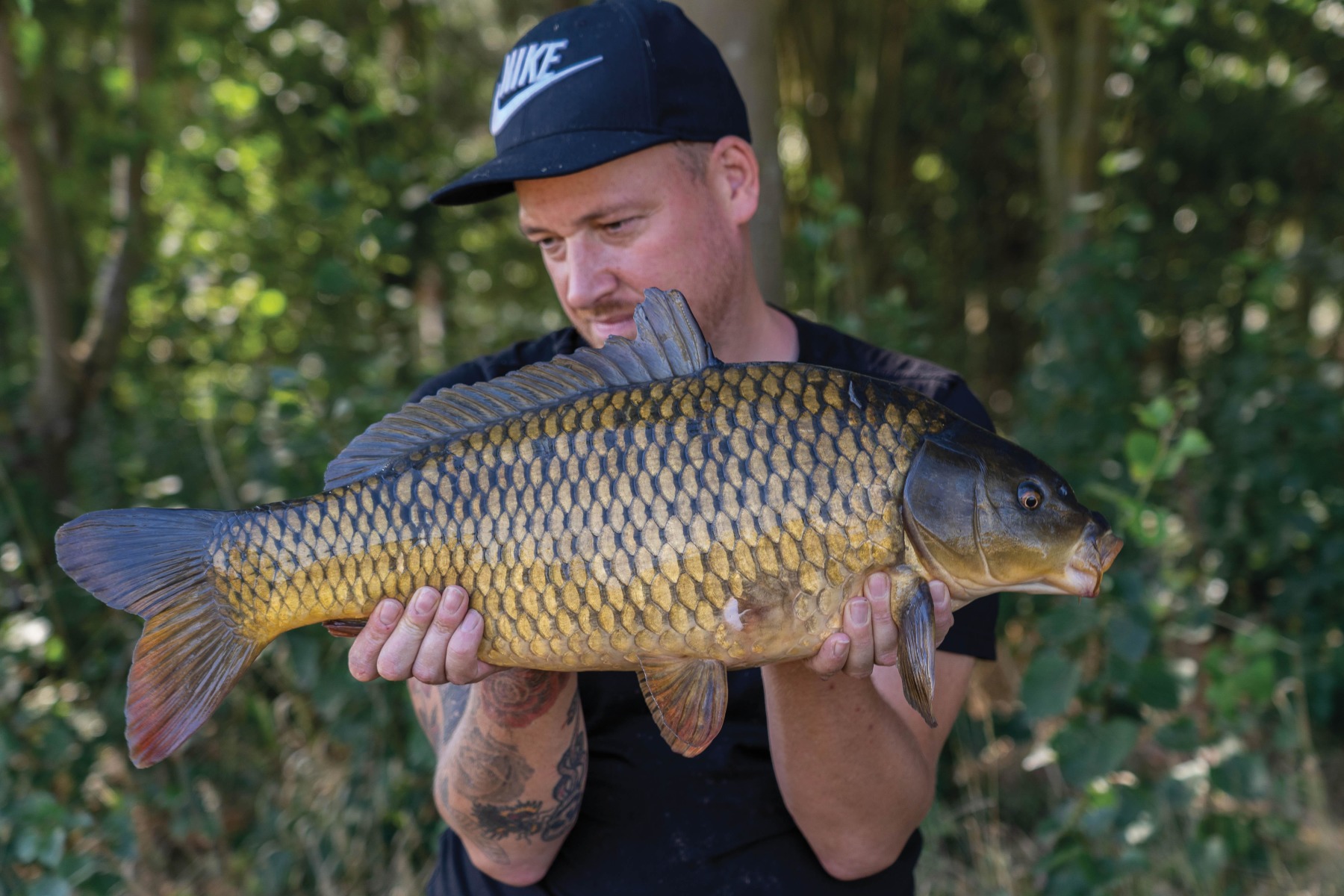
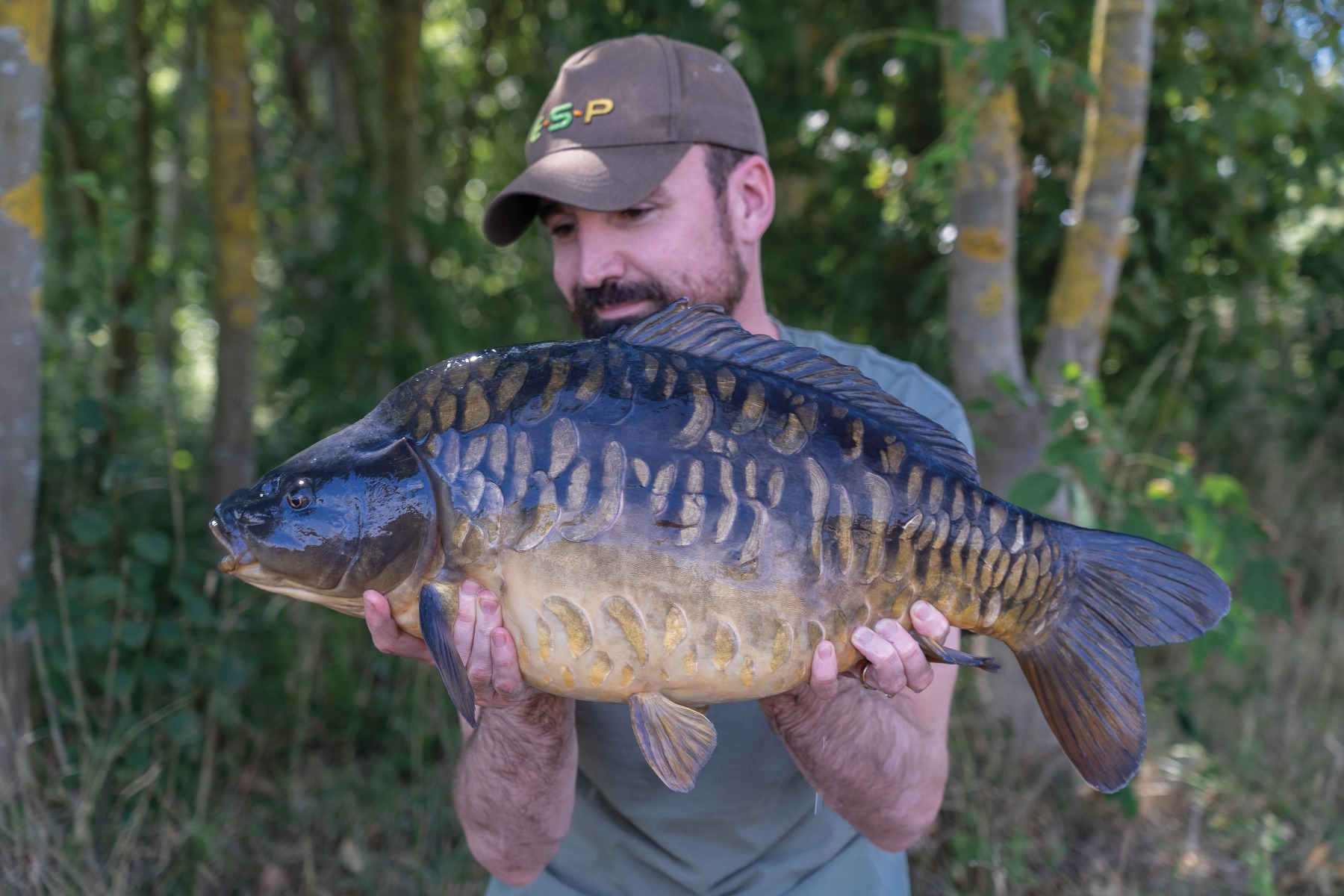
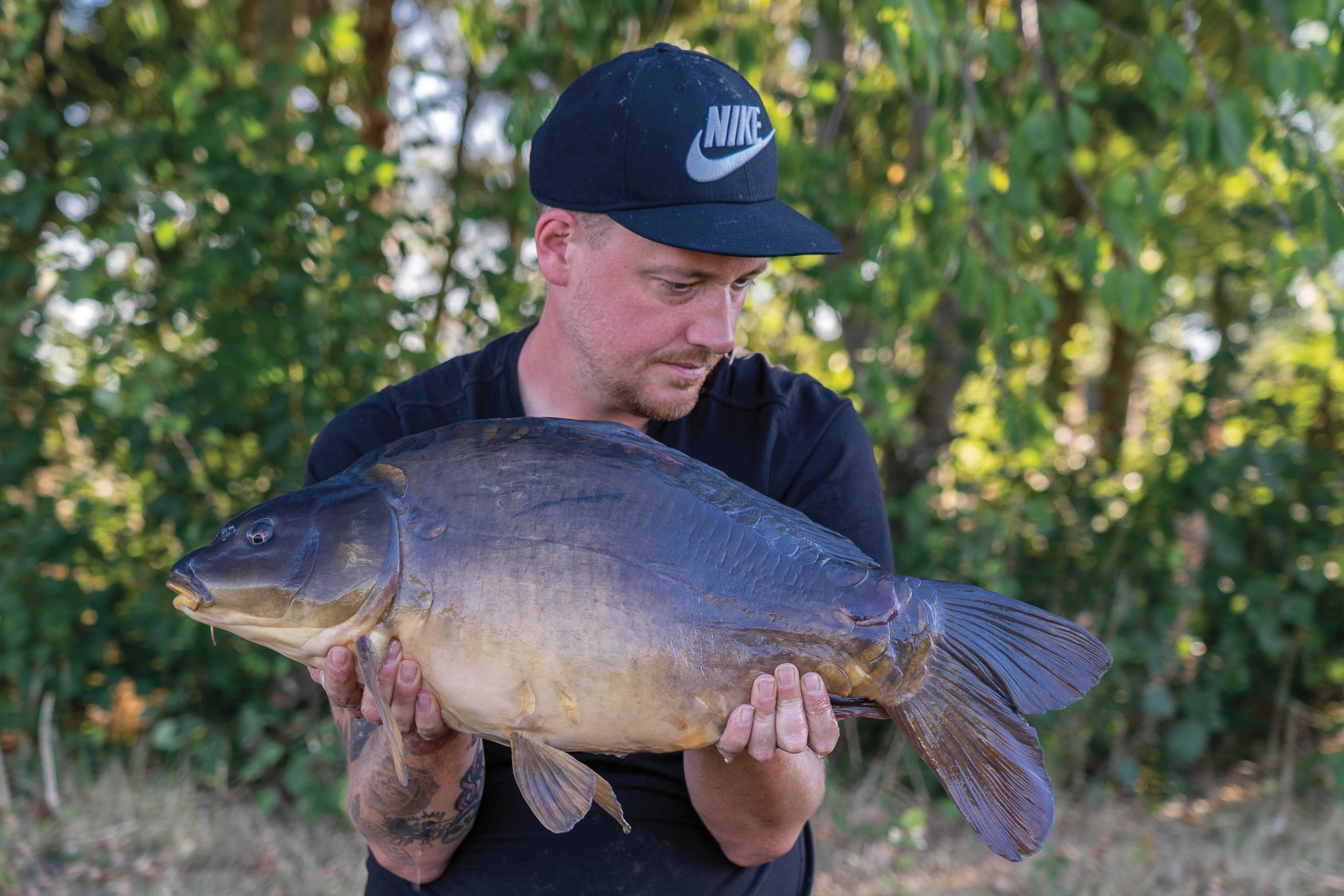
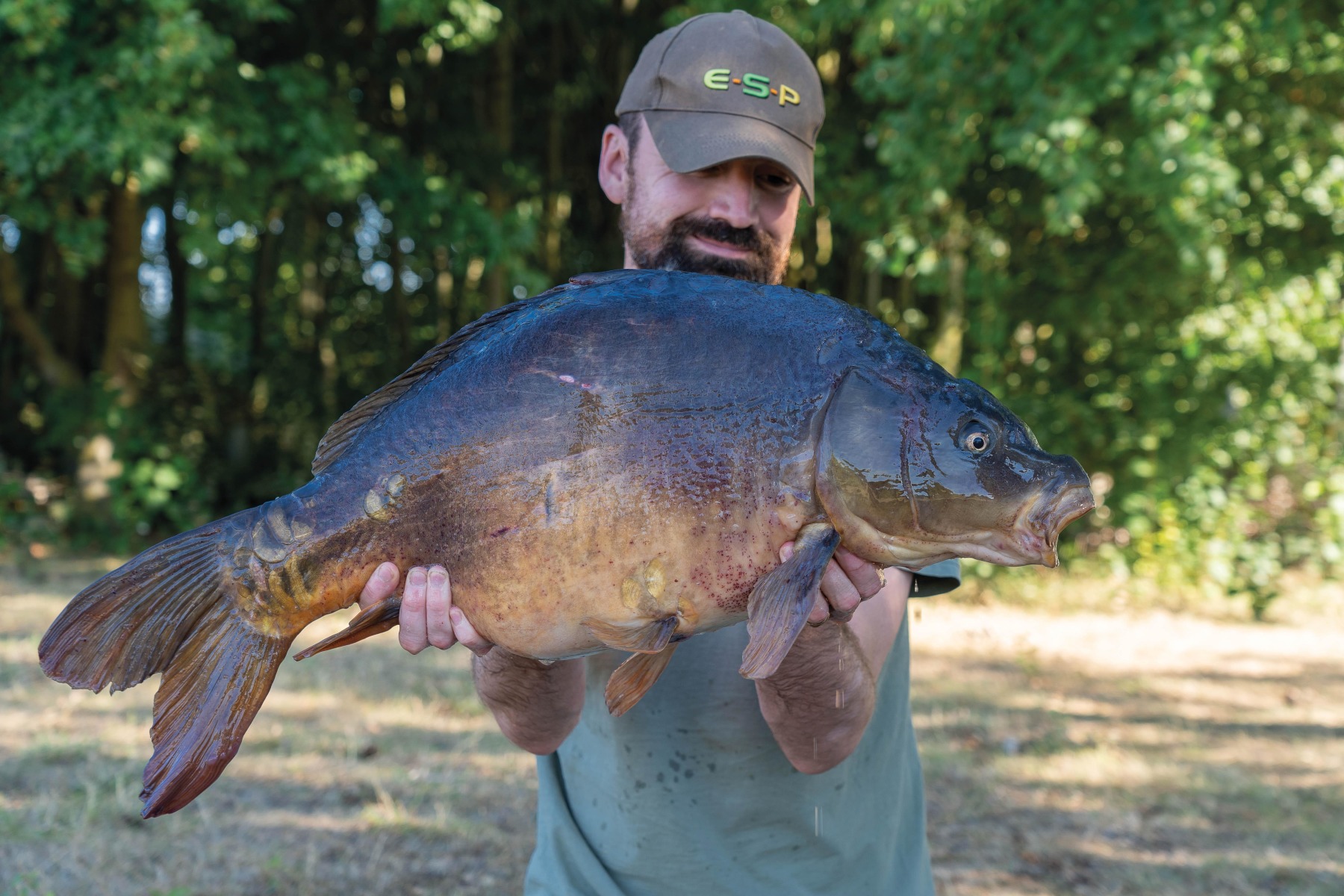
SL: By this time, I was working the swim hard, almost match-style. I was using the Gemini Tidy Stems to ensure that I had solid bags ready to go, and was getting straight back out after every fish. It was obvious that there were a few fish about, so I chose to give them a bit of bait. This was the first place I’d been in a while that allowed nuts, and I really wanted to give the chopped tigers from Carbon Baits a go. To these I added pellet, corn, rock salt and some 12mm Sticky The Krill Active.
I staggered what I fed as I didn’t want to ruin what was already quite steady sport. I put three Spombs over the right-hand rod, six over the middle one and gambled on the left-hander with a dozen. The fish reacted immediately, and the left-hander became the most productive. I topped up with three Spombs after each fish, and by the time it had got dark I had landed ten fish, all low to upper-doubles. I put the rods back out one more time, but after each subsequent bite, I left them against the brolly and got some sleep.
Later, I woke at a reasonable hour, and using my pre-tied bags, I got the rods straight back out, following up with a couple of Spombs over each. I had moved two rods to the left-hand spot as this had been the most productive, sacrificing the rod fished against the tree. The action resumed immediately, but the next bite felt different. The fish kited hard to the left and felt heavy. I felt none of the violent head-shakes of the previous doubles. It plodded around, rather than charge left and right, and it took a bit longer to crank in. In the beautifully clear margins, we could see that it was a slightly better fish, and when we slid the net under it, we thought it could be the first twenty of the session.
After this, things took a turn for the worse as I lost the next six fish in a row. I think they were all low-double, recently stocked fish. Their mouths were still quite soft and the hooks were slipping quite easily. After my losses, I decided to take a bit of a break and see how Chris had been getting on.
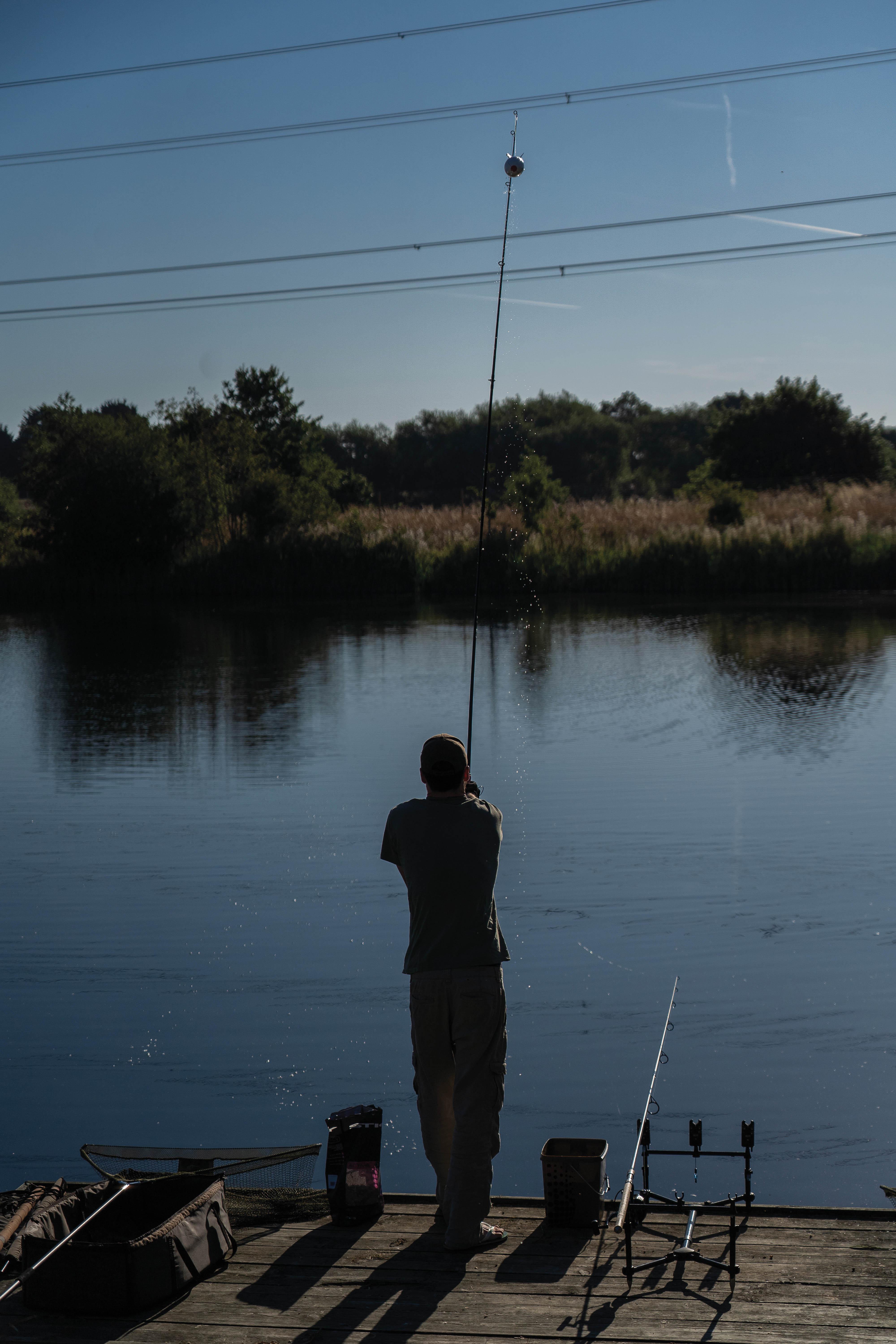
CE: My night had been much less hectic than Stu’s. I had picked up a couple of fish, but takes had been few and far between and the carp were of no better stamp. I felt that the fish may have left the area, but I couldn’t be sure. With there having been so many there the day before, I found it hard to believe that they had all vacated. I skipped in one of the rods and changed the rig to a little Slip-D with a Sea Monsta bottom bait and Cornz topper. Cornz hookbaits are a great way of adding a fleck of colour on venues that ban plastics. I added a little PVA mesh Stick of the matching Sea Monsta mix and fired it back out to the snaggy bush. As I settled the line before I attached the bobbin, the rod was almost pulled from my hand!
I played in another beautiful, double-figure mirror that proved beyond doubt that there were still fish out in front of me. I still wanted to look for an opportunity of picking up a better fish, though, so I went for a walk. There were loads of fish up and down the far margin, the greatest concentration of them being around the pellet feeders. I saw a lot of carp, including some better ones and a really nice mid- to upper-twenty common, so decided to spend a bit of time targeting that area. One of the massive benefits of hiring a venue exclusively, is that you’re able to move onto fish, as and when you find them.
It was a long way out to the feeders given the gear I had with me, but it was just about achievable. It took me a few casts with each rod, but eventually they were out in the general area. The Hinged Stiff Rigs were perfect for getting the distance without any worry of tangling. I had changed the hookbaits over to little white bright ones to try and bring about quicker bites. I also fed a few floaters either side of the peg, to see if they would get a few fish going. I had to wait about an hour, before eventually, one of the long-range rods trundled off.
The fight was crazy at such long range, and it soon became clear that it was another one of the pretty little doubles. Over the next couple of hours, I steadily added a few more fish. Sport was more consistent than that from the corner peg, but I was still struggling to get through to a better stamp of fish. I had been feeding floaters throughout the day and the fish were now taking them with confidence, so I decided to turn my attention to those for a while, and have a bit of fun.
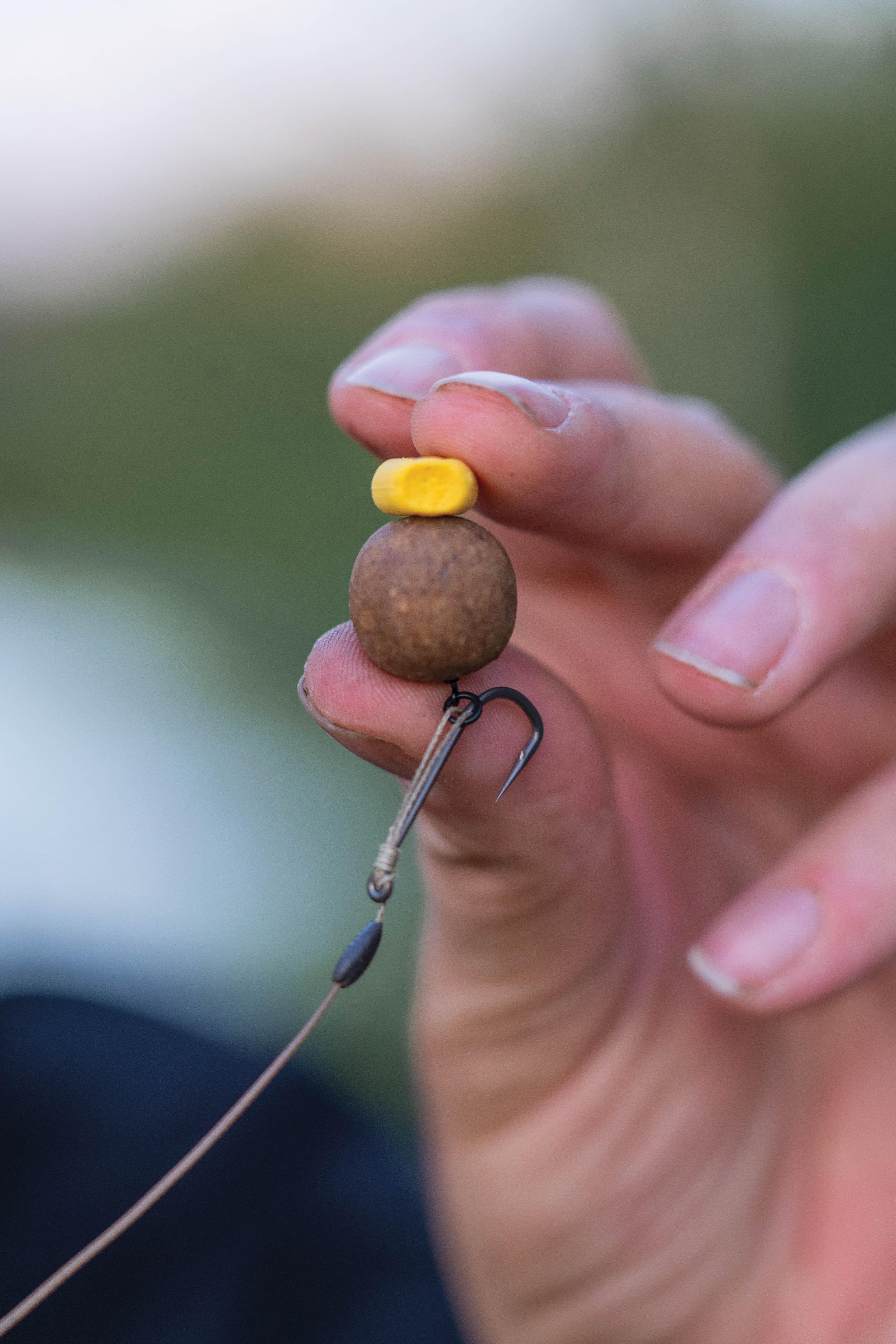
SL: Chris had been catching a few fish at range, and whilst the sport was pretty steady in my peg, I decided to wander down and fish next to him, just to do something different. I switched over from the solid bag set-up to a Slip D-Ronnie incorporating a Gemini Tidy Boom, size 6 ESP Cryogen Curve Shanx and a 4oz lead. I had recently taken delivery from Smudge Leads, having seen them advertised in this very magazine. A lead is a lead, so at 80p to £1 each, they represent really good value for money, especially as their quality is on a par with any of the big, branded leads. I have purchased cheaper leads previously, but the colours haven’t been quite right, or the coating has tended to crack. That’s not been the case with the models from Smudge.
I fed a bit of scalded pellet mush with some of Krill Active in front of a large bush on the far bank, and blasted out a washed-out, yellow, mulberry-flavoured homemade pop-up to the spot. The wait was a little bit longer, but after about 45 minutes, I was into my first fish from range. The long-range fight was fun, the fish kiting long distances and needing to be cranked all the way in. I’ve found hook-holds on Slip-D Ronnies to be solid, and as such, this next fish broke my run of losses.
Alternating between white blackcurrant, and yellow mulberry hookbaits, I continued to pick up fish. It was fun, but my arms were starting to ache. Chris had snared another fish off the top, so I joined him and had another one myself from the surface. We were really enjoying having the lake to ourselves, being able to just pick up fish on a whole host of tactics from almost every single peg. If you were to book the lake yourself, regardless of which peg you end up in, there are plenty of fish to be caught, if you get your tactics right.
The afternoon dwindled away, Chris and I catching plenty more fish, and before long, it was time to get ready for our final night. I decided to stick with Ronnies on all three rods, just to avoid having to tie up any more bags. I put white hookbaits on the left and middle rods, and spodded the usual mix of tigers, corn, pellet and boilies over the top. On the right-hand rod, I decided to try something different by way of a 14mm, match-the-hatch pop-up, made using a Sticky The Krill Hookbait Kit, glugging the offering in L-Zero-30T and Pure GLM Extract. Directly over the hookbait, I fed only whole boilie, putting out about 750 grams of 12mm baits.
As darkness fell we enjoyed some well-earned, ice-cold beers—one of the perks of having a fridge in the on-site club house. We chatted for hours, well into the night, adding a few more fish before we finally retired. The left and middle rods were busy, and I eventually laid them against the brolly around midnight.
The right-hand rod with the Krill pop-up remained strangely quiet. I enjoyed a leisurely lay-in, but was eventually woken by the remaining rod. I lifted into the fish and again it felt slightly better than the rake of doubles we had been catching. Another nice, heavy plod around the swim followed, and when it entered the margins, I could see it was another nice fish over 20lb. I scooped it up and took a closer look. It was an absolute dinosaur! It had clearly been around a while, with its battle-scarred flanks and a big, knobbly head. It had a huge frame and could easily have been much bigger in the past.
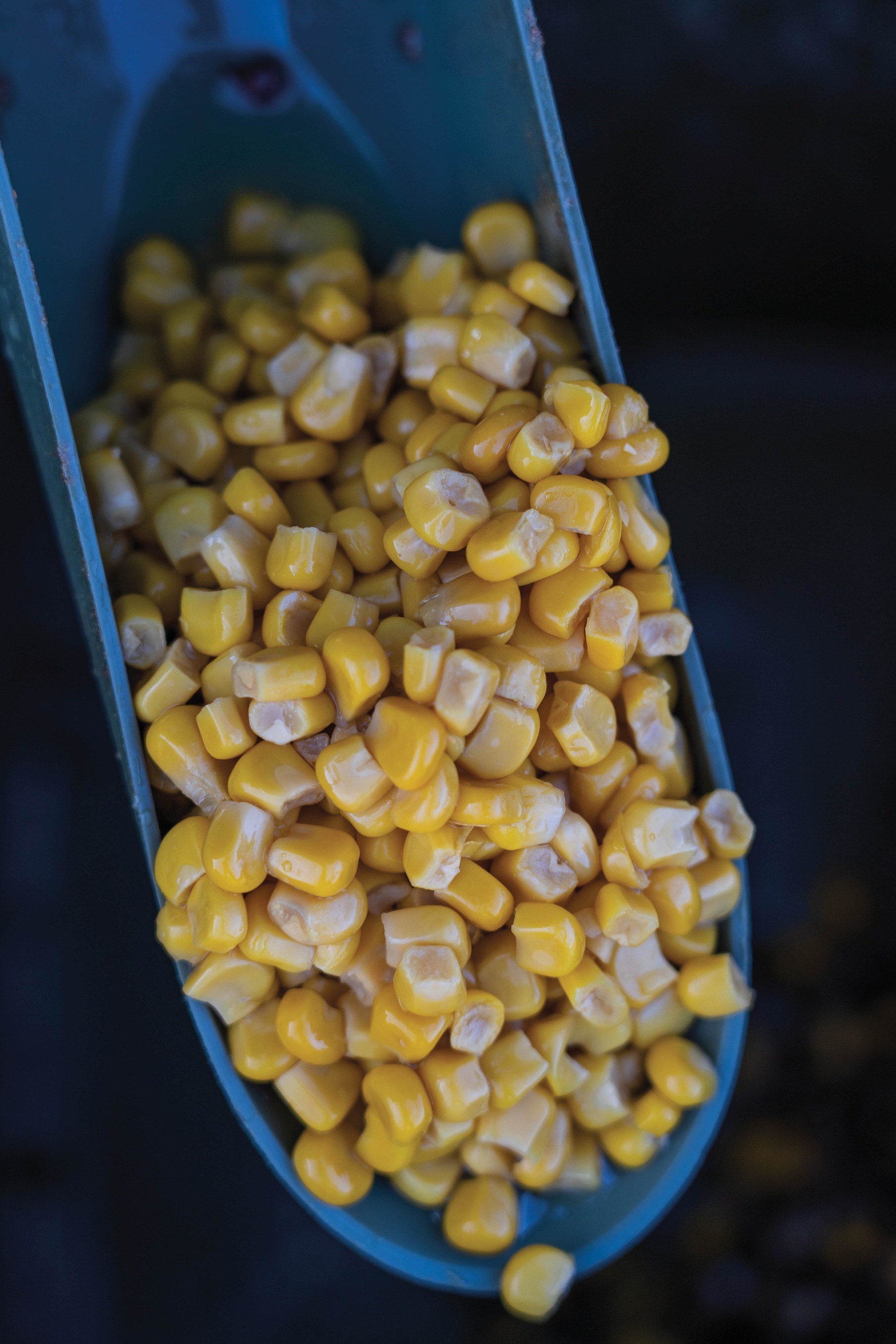
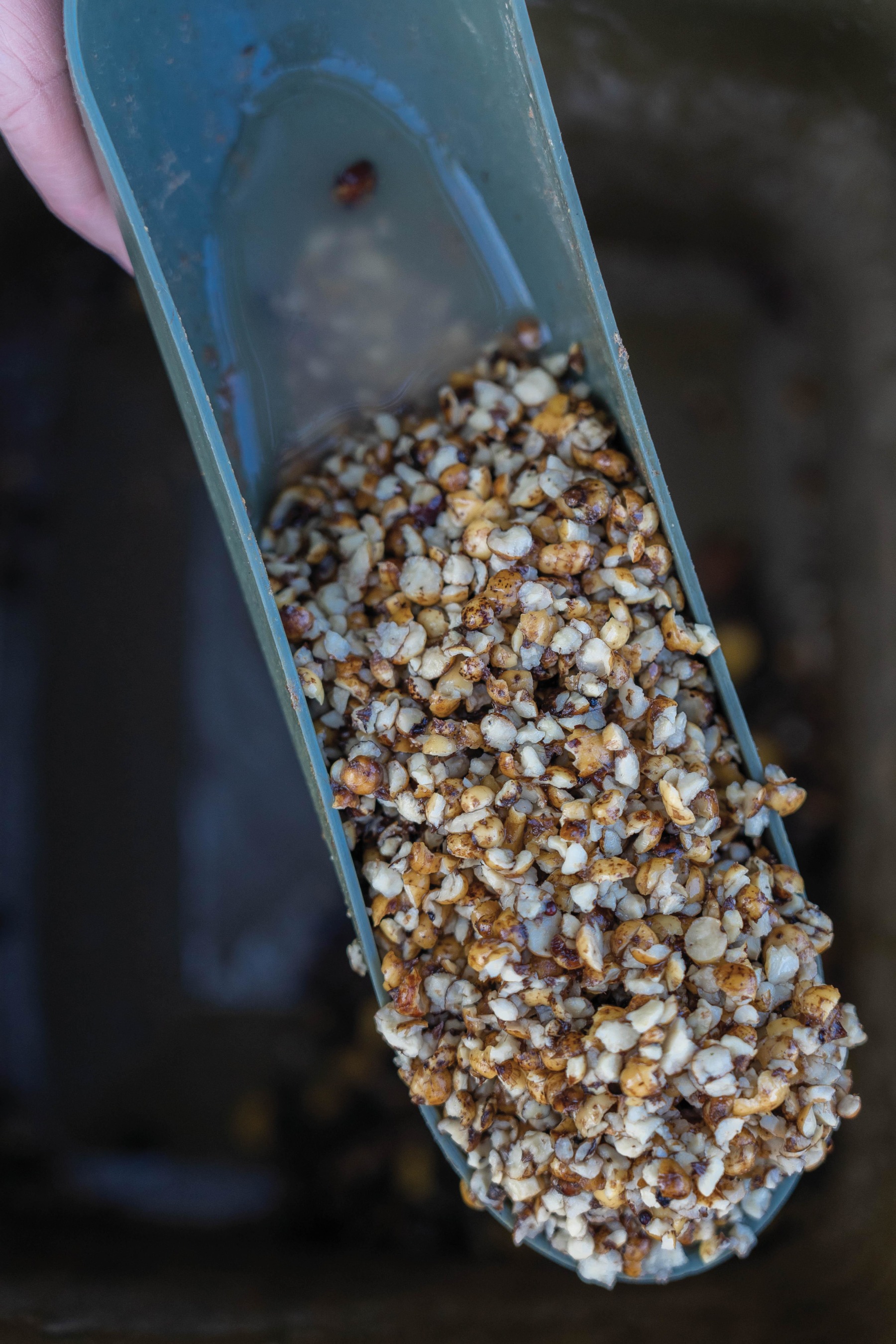
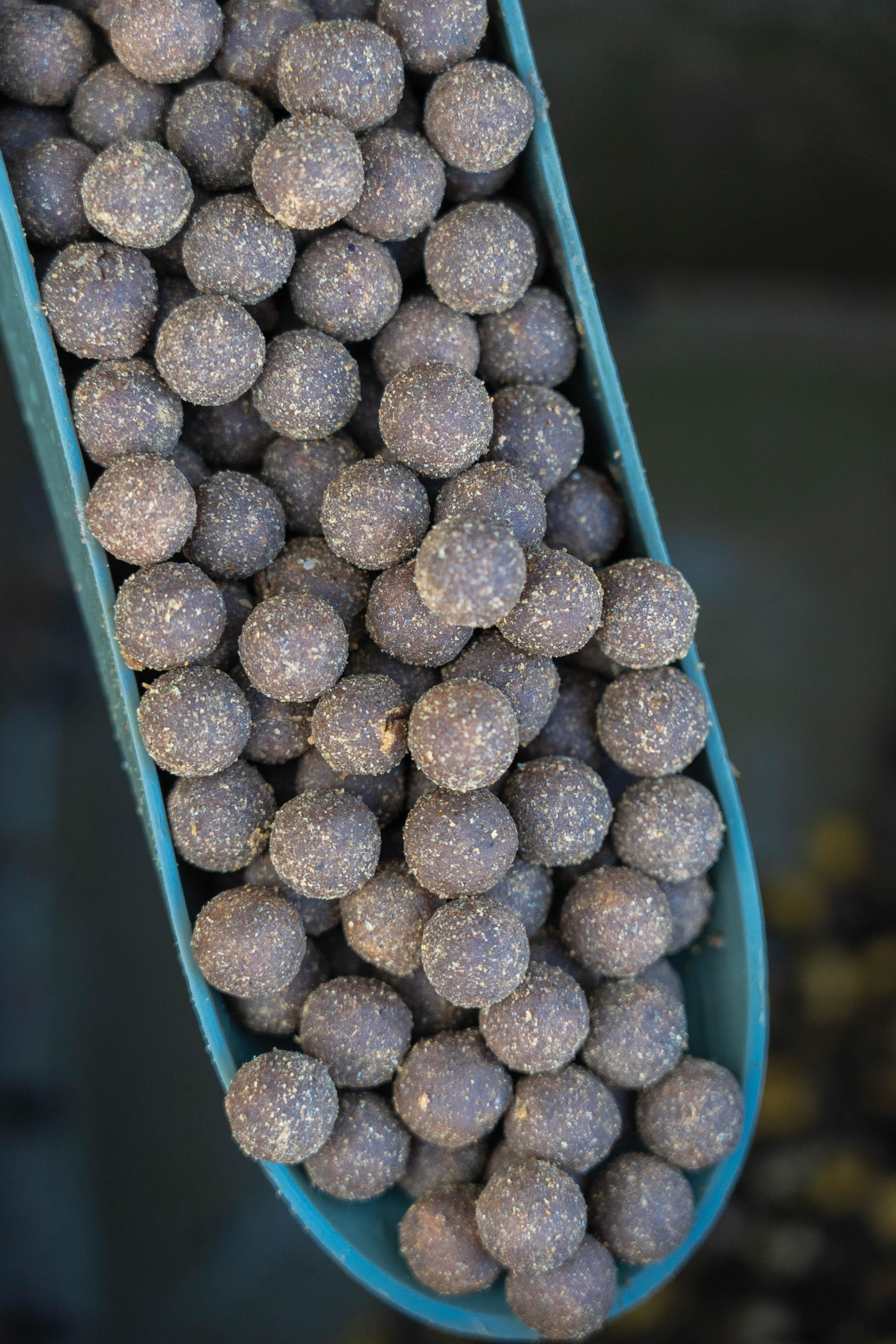
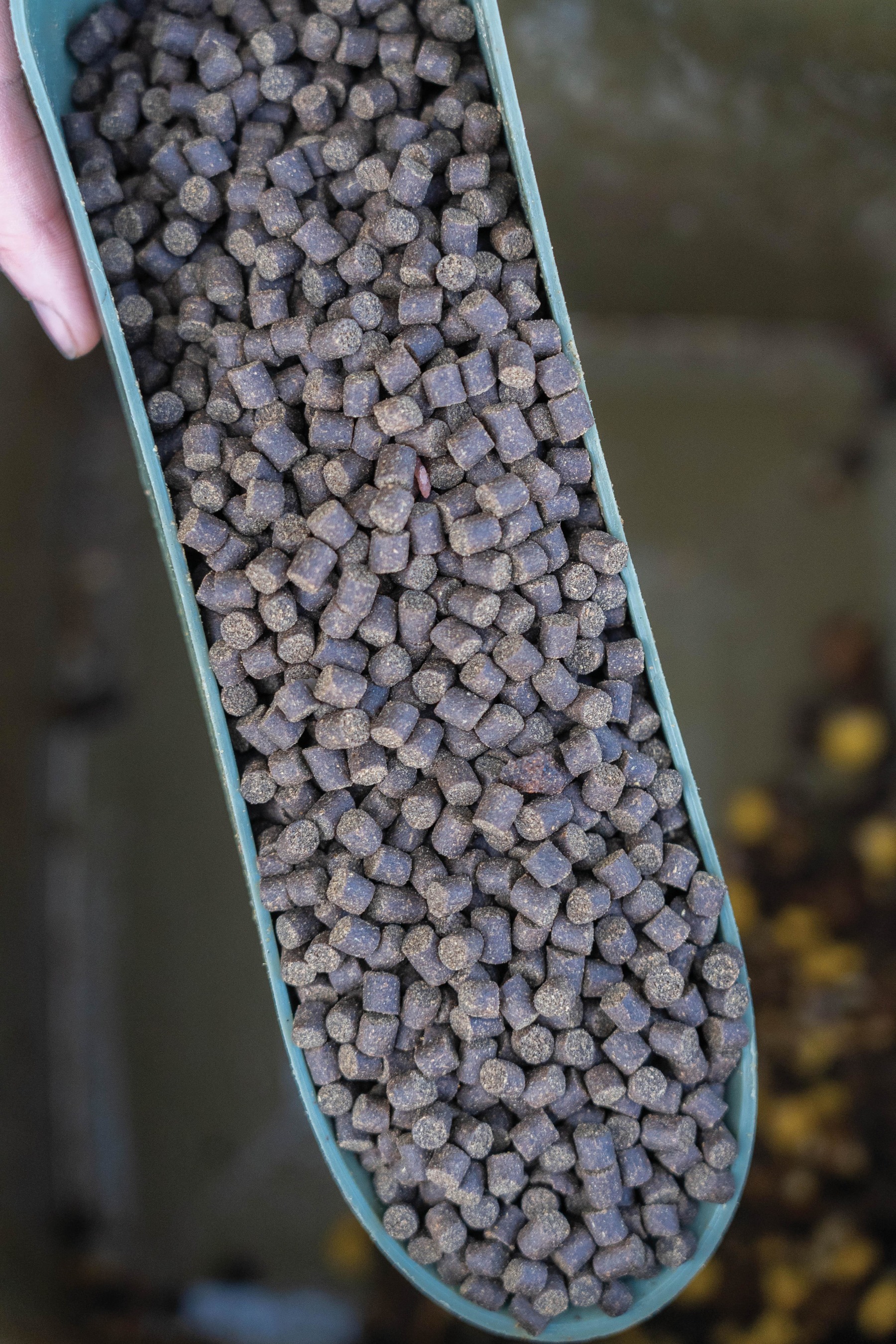
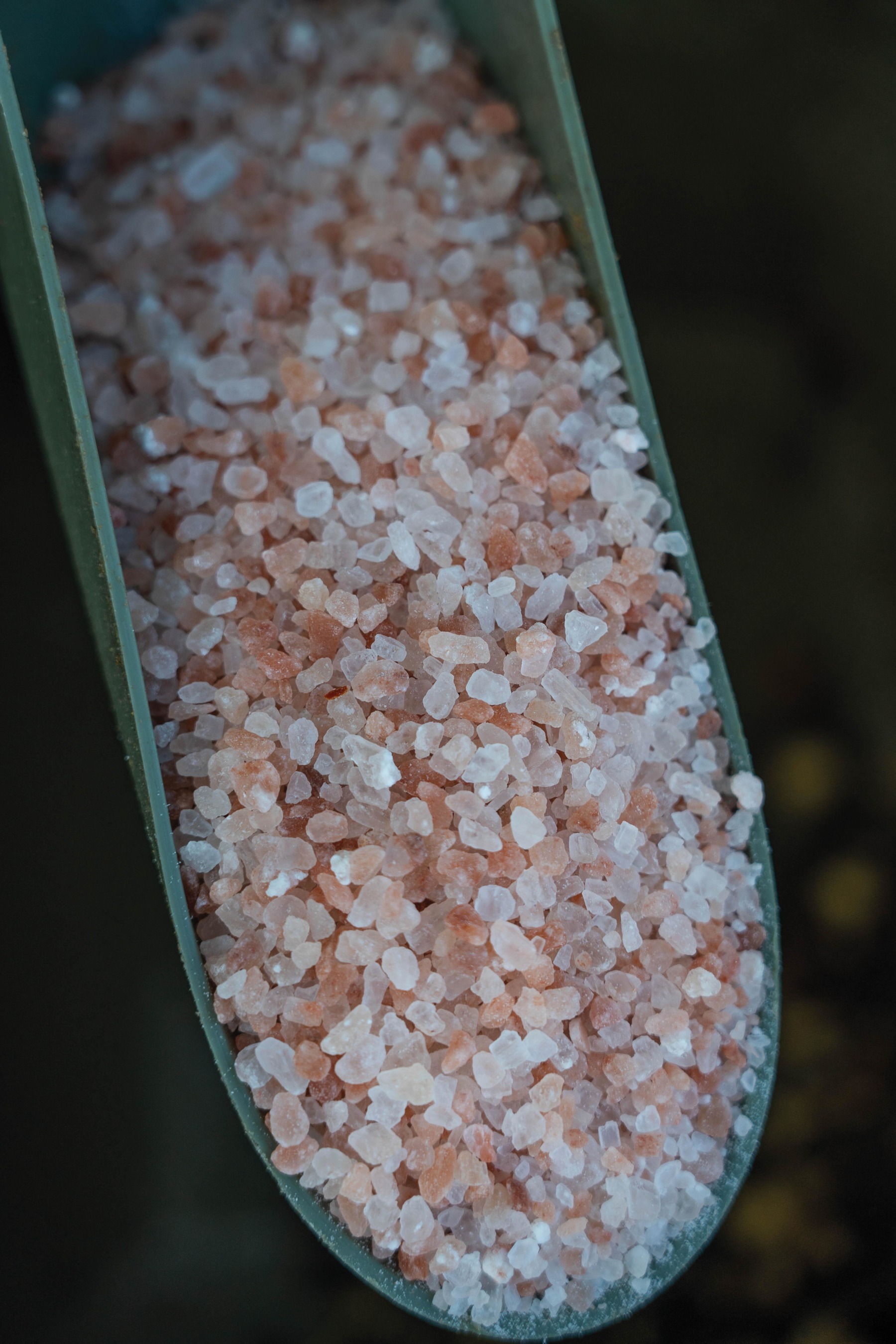
Whether it had come in from the larger lake with the flood or had always resided in the Cove was unclear, but it was obviously a very old fish. I was chuffed to bits and released it. Interestingly, the rod on the match-the-hatch hookbait fished over straight boilie had resulted in a better fish, so I decided to try this approach on all three rods for the last couple of hours. With all three out on the same Krill pop-ups, I spread another kilo over them all. The same rod was soon away again. Remarkably, the fish also felt better as it powered out of the swim back into the main part of the lake. I applied as much pressure as I could as it approached the collapsed feeder platform. Unfortunately, as it rolled right in front of it, the hook popped out—my first-ever hook-pull on a Slip-D Ronnie.
I tied a fresh Ronnie section and got the rod back out. I didn’t have to wait long before one of the rods was away again. The next fish felt better once again—I couldn’t quite believe what was happening. After playing it in I watched a lovely common twist and turn in the clear margins. It looked very similar to one of the fish we had seen feeding over on the far side. Eventually, it was ready, and I slipped the net under the second twenty of the morning. I redid the rod before starting to collapse the brolly and fold up the bed.
With almost my entire camp cleared, one of the rods was away. The final fish of the session was a fat football of a common. Remarkably, it went 20lb on the nose. Having caught over fifty fish between us, most of which had been doubles, I had landed three twenties in a row on the final morning.
CE: The Cove is absolutely ideal for exactly what it was designed to provide: sociable fishing with plenty of carp to be caught. We’d enjoyed a fantastic trip, shared plenty of laughs and had banked loads of fish. If only all our trips were that easy!
What would we do differently next time?
CE: Having had so much success at Tar Farm on the Hinged Stiff Rig, I think I sat it out on the set-up for too long. I should have changed to solid bags or low-lying Ronnies a bit earlier and played the numbers game to get through to the twenties.
SL: I wish I had experimented with match-the-hatch hookbaits and feeding straight boilie earlier in the session. Whether it was coincidence or not, after making the change, the final three fish of the session were all twenties. I wonder how many more we could have had if I had changed earlier.
